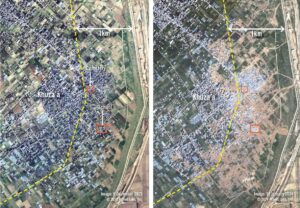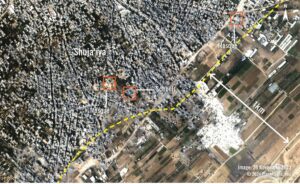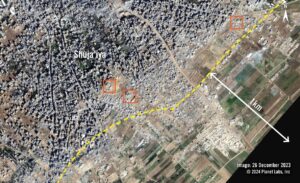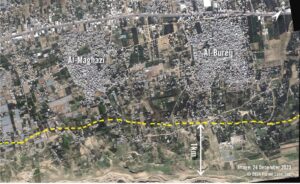- Farms bulldozed and apartment blocks demolished across eastern Gaza
- Satellite imagery and social media videos reveal extent of destruction
- Thousands of homes destroyed and land left uninhabitable
The Israeli military’s campaign to significantly expand a “buffer zone” along the eastern perimeter of the occupied Gaza Strip should be investigated as the war crimes of wanton destruction and of collective punishment, Amnesty International said in a new investigation.
Using bulldozers and manually laid explosives, the Israeli military has unlawfully destroyed agricultural land and civilian buildings, razing entire neighbourhoods, including homes, schools and mosques.
By analyzing satellite imagery and videos posted by Israeli soldiers on social media between October 2023 and May 2024, Amnesty International’s Crisis Evidence Lab identified newly cleared land along Gaza’s eastern boundary, ranging from approximately 1km to 1.8km wide. In some videos, Israeli soldiers are seen posing for pictures or toasting in celebration as buildings are demolished in the background.
“The Israeli military’s relentless campaign of ruin in Gaza is one of wanton destruction. Our research has shown how Israeli forces have obliterated residential buildings, forced thousands of families from their homes and rendered their land uninhabitable,” said Erika Guevara-Rosas, Amnesty International’s Senior Director for Research, Advocacy, Policy and Campaigns.
“Our analysis reveals a pattern along the eastern perimeter of Gaza that is consistent with the systematic destruction of an entire area. These homes were not destroyed as the result of intense fighting. Rather, the Israeli military deliberately razed the land after they had taken control of the area.
“The creation of any ‘buffer zone’ must not amount to the collective punishment of the Palestinian civilians who lived in these neighbourhoods. Israel’s measures to protect Israelis from attacks from Gaza must be carried out in conformity with its obligations under international law, including the prohibition of wanton destruction and of collective punishment.”
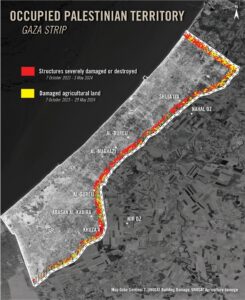
The map of Gaza above highlights the damage and destruction occurring between October 2023 and May 2024 within one kilometre of the fence line. Over 90% of the buildings have been severely damaged or destroyed, and 59% of the cultivated land has declined significantly in health within the area.
Israeli officials have acknowledged the destruction of structures along Gaza’s eastern perimeter as a security measure, in response to the attacks of 7 October 2023 by Hamas and other Palestinian armed groups, to protect Israeli communities from further attacks. The Israeli military has justified demolitions throughout Gaza saying it had destroyed tunnels and other “terror infrastructure“.
On 2 July 2024, Amnesty International sent questions regarding the demolitions to the Israeli authorities. At the time of publication, no response had been received.
Military necessity and international humanitarian law
The expanded “buffer zone” along the perimeter with Israel covers approximately 58km², which amounts to roughly 16% of the entire occupied Gaza Strip. As of May 2024, more than 90% of the buildings within this area (more than 3,500 structures) appear destroyed or severely damaged; and more than 20km² or 59% of agricultural land within the area shows a decline in health and density of crops due to the ongoing conflict.
Amnesty International interviewed affected residents and farmers, analyzed satellite imagery, verified 25 videos filmed along the perimeter area, and tracked statements issued by the Israeli military, Hamas and other armed groups to determine whether the destruction was lawful, including whether it could be justified by imperative military necessity.
In four areas investigated by Amnesty International, the destruction was carried out after the Israeli military had operational control over the areas, meaning that it was not caused by direct combat between the Israeli military and Hamas and other Palestinian armed groups. In these parts of the Gaza Strip, structures were deliberately and systematically demolished.
It appears that many of the structures were demolished because of their proximity to the fence built by Israel to separate it from the Gaza Strip. While some of the structures were likely previously used by armed groups, the possible future use by armed groups of civilian objects – whether due to their proximity to the perimeter or for other reasons – does not in itself transform homes, schools, or mosques into military objectives. Furthermore, punitive demolition of civilian property solely because it has been used by armed groups is prohibited as a form of collective punishment.
International humanitarian law, which is binding on all parties to an armed conflict, prohibits destruction of property of an adversary unless it is required by imperative military necessity. Direct attacks on civilian objects are also prohibited.
The principle of military necessity allows a party to the conflict to take measures which are necessary to weaken the military forces of its adversary, and which are not otherwise prohibited by international humanitarian law. In the case of the prohibition of destruction of an adversary’s property, there is an explicit exception for “imperative military necessity”, allowing for destruction of property when it serves a legitimate military purpose and does not violate other rules of international humanitarian law including, amongst other things, the principle of proportionality and the prohibition of collective punishment.
An example of a legitimate purpose would be destroying a structure providing cover for an enemy to fire at one’s own forces during active combat. This tactical application does not apply in the cases documented here, as at the time of the demolitions Israeli forces had control of the areas and fighting had largely ceased. Even when destruction may serve a legitimate military purpose, the extent and manner of such destruction is limited by the principle of proportionality as well as other rules of international humanitarian law, including those governing military occupations.
If the Israeli military believed it was militarily necessary to establish a “buffer zone” to protect people inside Israel from attacks by armed groups, there appear to be other options in Israeli territory to achieve that objective that would comply with international humanitarian law and Israel’s obligations as the occupying power. Given the viability of these other options and the failure to pursue them, the extensive and systematic destruction is disproportionate to any possible legitimate military purpose. These cases should therefore be investigated as the war crime of wanton destruction. In light of the evidence that some destruction of homes and other civilian property was carried out to punish civilians for attacks by armed groups, this conduct should also be investigated as the war crime of collective punishment.
The International Court of Justice (ICJ) concluded in an Advisory Opinion in 2004 that Israel’s construction of the wall inside the occupied West Bank was unlawful. The ICJ emphasised that Israel’s security measures must comply with its obligations under international humanitarian law, including as the occupying power, and under international human rights law. This includes considering construction alternatives in Israeli territory that displace fewer civilians and provide fair reparations for those civilians who have lost property and livelihoods.
The prior military use of civilian structures does not alone justify demolition of civilian property, let alone excuse the wholesale destruction of entire neighbourhoods and of agricultural land required to feed the civilian population.
Khuza’a: ‘All around is just destruction’
The town of Khuza’a in the Khan Younis governorate in southern Gaza was home to approximately 11,000 Palestinians. In the seven weeks following 7 October 2023, satellite imagery shows that an estimated 178 structures in and around the town were destroyed or severely damaged – many by airstrikes. However, more significant destruction started once Israeli ground forces entered the town at a larger scale in late December 2023. More than 850 structures were destroyed or severely damaged between 26 November 2023 and 7 January 2024, according to UNOSAT.
On 27 December, the Israeli military announced it had started an operation dubbed “Oz and Nir” in reference to the Nir Oz kibbutz, a community in the so-called “Gaza envelope” that was attacked by Hamas and other armed groups on 7 October. Brigadier General Avi Rosenfeld, the commander of the Israeli military’s Gaza Division, wrote in a message to troops: “On the cursed Sabbath, October 7, the horrible terrorists, who committed the most horrible crimes imaginable, came from Khirbat Khizaaa (Khuza’a). We will work with all our might to eliminate the terrorists hiding there above and below the ground, and to dismantle the infrastructures of terrorism and evil.”
On 28 December, an Israeli soldier from the 8219 Engineering Battalion published the first video on social media of a demolition in Khuza’a. He wrote: “On 7/10, many terrorists came out of the houses here to slaughter the residents of Nir Oz. Tonight, we destroyed 30 of them.” Satellite imagery confirms that at least 30 houses in the area were destroyed between 26 and 30 December 2023.
Satellite imagery shows a section of Khuza’a was destroyed between 26 and 30 December 2023.
In the days that followed, the same soldier posted five more videos showing explosive demolitions, most of them filmed from the same rooftop. Soldiers appear smiling and posing for the camera, smoking cigarettes or shisha pipes, or toasting with drinks while blasts destroy several buildings in the background. In one of the videos, three soldiers walk towards the camera as an explosion is detonated behind them. The text in Arabic reads: “We came back from the dead to haunt you.” The soldiers’ actions in the videos indicate there was no imminent threat at the time and location.
On 29 December, the Israeli military announced that its soldiers were working to gain operational control over Khuza’a, and claimed they had found dozens of tunnels, weapons and rocket launchers. Al Qassam Brigades, the military wing of Hamas, had previously announced on its Telegram channel that it had launched rocket-propelled grenades and mortars at Israeli troops from the Khuza’a area.
On 3 January 2024, the Israeli military took a crew from Israel’s Now 14 TV around Khuza’a. Soldiers showed how they used M15 anti-tank landmines to destroy buildings. The crew interviewed soldiers next to buildings set to be demolished, indicating there was no imminent threat. Cables were seen being set around a structure with the numbers 8219 marked on the walls, which is the designation of the Engineering Battalion.
On 10 January, the Israeli military announced it had completed its operation in Khuza’a and said it had “destroyed hundreds of terrorist infrastructures, rocket launch positions and observation posts,” adding that soldiers “eliminated dozens of terrorists and uncovered and destroyed about 40 tunnel shafts”.
However, satellite imagery and videos revealed troops had also destroyed hundreds of residential buildings, a cemetery and a primary school. Most of the buildings demolished stood within 1km to 1.2km of the perimeter fence. Systematically destroying civilian objects in retaliation for actions by armed groups may constitute collective punishment and should be investigated as a war crime.
Satellite imagery from 6 December 2023 and 16 January 2024 shows the destruction of land and structures in Khuza’a. The area within 1 kilometre of the fence line – demarcated with a yellow dashed line – is heavily scraped with almost every structure destroyed. The destruction continues beyond the 1 kilometre line in some places.
Dr Salem Qudeih, a teacher who lived in Khuza’a with his family, told Amnesty International: “My home was about 1,650m from the border [with Israel]. We left home on 11 October because the area had become too dangerous.
“Around my family home we had a three dunam (0.7 acre) orchard full of fruit trees. They were all destroyed. Only an apple tree and a rose were left. I had bees and produced honey. All of it is gone now. Out of the 222 houses of my relatives in the area, only about a dozen remain. My home – where I lived with my wife, my five daughters and one son – was completely destroyed.”
Tahani al-Najjar, a 42-year-old Khuza’a resident, told Amnesty International: “The shelling started on the first day [8 October 2023]. My uncle, his wife, children and grandchildren were killed on that first morning… seven people.
“After that we all left the area, with all the relatives from my extended family. We are more than 500 families… My son went to check on our home recently and found that our home is about the only one which is still standing in our area, but it is badly damaged. All around is just destruction…
“In our area, the al-Najjar families mostly had orchards around the homes, where families grew their fruits and vegetables. And all around the area were larger farms which produced vegetables and poultry. Much of the food produced in Gaza is from our area. People have not just lost their homes, but also their livelihoods. The whole of Gaza has lost its food production.”
Destruction from north to south
Other communities along the Gaza-Israel perimeter have suffered similar extensive destruction due to Israeli demolitions.
In Shuja’iya, one of Gaza City’s largest neighbourhoods, more than 750 structures within the Israeli imposed “buffer zone” and beyond have been severely damaged or destroyed between 26 November 2023 and 6 January 2024, according to UN data. Among them were two schools, mosques and dozens of residential buildings. The Israeli military claimed, without producing evidence, that some of these buildings held weapons, ammunition and tunnel shafts.
Satellite imagery from 26 November and 26 December 2023 show the destruction in Shuja’iya. The area within 1 kilometre of the fence line – shown with a yellow dashed line – is effectively cleared with almost every structure flattened. The destruction continues beyond the 1 kilometre line, up to 430 metres further into Shuja’iya.
One video posted on social media on 20 December 2023 shows Israeli soldiers of Engineering Battalion 749 celebrating the demolition of approximately 30 homes in Shuja’iya. There was no indication of any imminent danger for the soldiers while filming the explosion, which occurred approximately 200 metres from them. One soldier can be heard saying: “Nahal Oz, God willing, you’ll have a view of the sea.”
The soldier is referring to the kibbutz of Nahal Oz, which was attacked by Palestinian armed groups on 7 October 2023, and stands less than a kilometre from the fence on the Israeli side.
In another video posted on social media on the same day, a soldier standing on a building that was used as a base by the Israeli military filmed dozens of destroyed structures. The soldier says: “Sunrise at the rubble of what Shuja’iya used to be. The aerials of Nahal Oz can be seen from here, of the military base and the town.”
On 21 December, the Israeli military announced that it had gained operational control over the whole neighbourhood, which extends well into Gaza City, beyond the “buffer zone” analysed here. The Israeli military also said they had “destroyed over 100 terrorist structures, exposed and destroyed dozens of tunnel shafts”. While such structures would constitute military objectives, their presence within the neighbourhood does not justify the systematic destruction of every civilian structure within that space.
In central Gaza, the area around and east of Al-Bureij and Al-Maghazi refugee camps was razed between late December 2023 and January 2024. The timeline of destruction aligns with the Israeli military’s offensive in these two densely populated areas, where they claimed to have found weapons, rocket launchers and tunnel shafts. However, they provided no evidence or explanation of the imperative military necessity of destroying villages and agricultural land along the eastern perimeter, when the weapons and military objectives were reportedly found much further inside the Gaza Strip.
More than 1,200 structures were severely damaged or destroyed in the area between 26 November 2023 and 29 February 2024. The destruction reached up to 1.8km into the Gaza Strip from the perimeter fence, and over 3km from north to south, covering approximately 4km².
Satellite imagery from 24 December 2023 and 22 January 2024 shows destroyed land and structures around Al-Maghazi and Al-Bureij. More than 1,200 structures were severely damaged or destroyed between 26 November and 29 February.
Drone footage published on social media on 14 March shows several buildings on fire to the east of Al-Maghazi, approximately 900m from the perimeter fence. Israeli military vehicles are visible in satellite imagery on 10 January 2024, indicating they had control of the area, and the buildings appear to have been demolished between 10 and 12 January. The surrounding fields were bulldozed by 15 January 2024.
Further south, Al-Sureij and Abasan al-Kabira – two rural villages located approximately 1km from the perimeter fence – also had buildings and agricultural land destroyed by the Israeli military.
Satellite imagery shows the Israeli military advanced towards Al-Sureij in late December 2023. By the end of January 2024, roughly half of the village’s buildings had been demolished and surrounding fields scraped. Videos shared on social media on 19 and 20 January showed a cluster of houses blowing up. Neither the Israeli military or Palestinian armed groups published claims about their activities in and around Al-Sureij.
In late February 2024, the Israeli military pushed further in the region east of Khan Younis, where Abasan al-Kabira is located. Between 13 February and 13 March, the Israeli military claimed to have killed Palestinian fighters and found weapons and rocket launchers in the Abasan area, which comprises the towns of Abasan al-Kabira and Abasan al-Saghira.
The period coincides with the demolition of the Omar bin Abdul Aziz Mosque. This video, published on 19 February, shows soldiers walking in the area in a relaxed manner, with no indication of imminent danger.
International humanitarian law
International humanitarian law, which applies in situations of armed conflict, including during military occupation, is comprised of rules whose central purpose is to limit, to the maximum extent feasible, human suffering in times of armed conflict.
The four Geneva Conventions of 1949 and their two Additional Protocols of 1977 are the principal instruments of international humanitarian law. Many of these treaties’ rules are considered customary international law, meaning that they bind all parties to an armed conflict regardless of whether they have ratified particular treaties and whether they are a state forces or a non-state armed group.
According to this customary norm, “the destruction or seizure of the property of an adversary is prohibited, unless required by imperative military necessity”. In addition, according to article 53 of the Fourth Geneva Convention, which regulates the actions of Israel as the occupying power in Gaza: “Any destruction by the Occupying Power of real or personal property belonging individually or collectively to private persons, or to the State, or to other public authorities, or to social or cooperative organizations, is prohibited, except where such destruction is rendered absolutely necessary by military operations.”
According to article 147 of the Fourth Geneva Convention, “extensive destruction and appropriation of property, not justified by military necessity and carried out unlawfully and wantonly” is a grave breach of the Convention, and thus a war crime.
Where such destruction is carried out as collective punishment, it also violates article 33 of the Fourth Geneva Convention which provides: “No protected person may be punished for an offence he or she has not personally committed. Collective penalties and likewise all measures of intimidation or of terrorism are prohibited.”
Civilian property in armed conflict is also protected by the principle of distinction, which requires that parties to the conflict at all times, distinguish between “civilian objects” and “military objectives” and direct their attacks only at military objectives.
According to customary international humanitarian law, civilian objects are all objects which are not “military objectives”; and military objectives are “limited to those objects which by their nature, location, purpose or use make an effective contribution to military action and whose partial or total destruction, capture or neutralisation, in the circumstances ruling at the time, offers a definite military advantage”. Civilian objects are protected against attack, unless and for such time as they become military objectives when all of the criteria for a military objective are temporarily fulfilled Protocol I requires that, in cases of doubt, parties to a conflict should presume that the structure retains its civilian nature. Intentionally directing attacks against civilian objects is a war crime.




